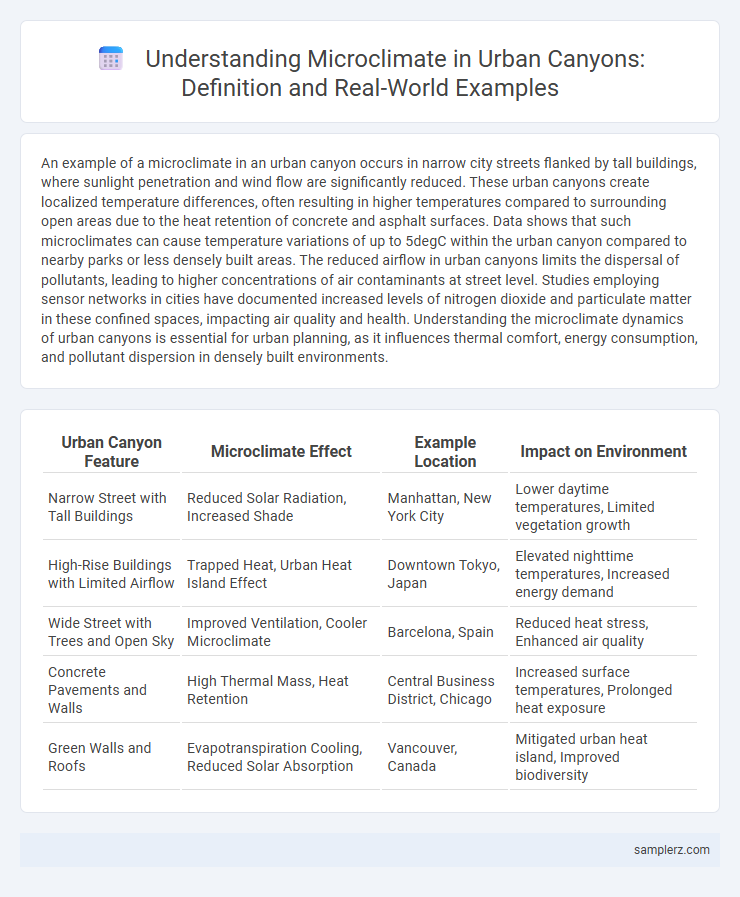An example of a microclimate in an urban canyon occurs in narrow city streets flanked by tall buildings, where sunlight penetration and wind flow are significantly reduced. These urban canyons create localized temperature differences, often resulting in higher temperatures compared to surrounding open areas due to the heat retention of concrete and asphalt surfaces. Data shows that such microclimates can cause temperature variations of up to 5degC within the urban canyon compared to nearby parks or less densely built areas. The reduced airflow in urban canyons limits the dispersal of pollutants, leading to higher concentrations of air contaminants at street level. Studies employing sensor networks in cities have documented increased levels of nitrogen dioxide and particulate matter in these confined spaces, impacting air quality and health. Understanding the microclimate dynamics of urban canyons is essential for urban planning, as it influences thermal comfort, energy consumption, and pollutant dispersion in densely built environments.
Table of Comparison
| Urban Canyon Feature | Microclimate Effect | Example Location | Impact on Environment |
|---|---|---|---|
| Narrow Street with Tall Buildings | Reduced Solar Radiation, Increased Shade | Manhattan, New York City | Lower daytime temperatures, Limited vegetation growth |
| High-Rise Buildings with Limited Airflow | Trapped Heat, Urban Heat Island Effect | Downtown Tokyo, Japan | Elevated nighttime temperatures, Increased energy demand |
| Wide Street with Trees and Open Sky | Improved Ventilation, Cooler Microclimate | Barcelona, Spain | Reduced heat stress, Enhanced air quality |
| Concrete Pavements and Walls | High Thermal Mass, Heat Retention | Central Business District, Chicago | Increased surface temperatures, Prolonged heat exposure |
| Green Walls and Roofs | Evapotranspiration Cooling, Reduced Solar Absorption | Vancouver, Canada | Mitigated urban heat island, Improved biodiversity |
Defining Microclimates in Urban Canyons
Urban canyon microclimates are characterized by unique temperature, humidity, and airflow patterns created by the close arrangement of tall buildings and narrow streets. These microclimates exhibit significant variations in solar radiation distribution and wind dynamics compared to open areas, leading to localized heat islands and altered pollutant dispersion. Understanding urban canyon microclimates is essential for effective urban planning and mitigating adverse environmental impacts such as increased thermal stress and reduced air quality.
Key Factors Influencing Urban Canyon Microclimates
Urban canyon microclimates are significantly influenced by factors such as building geometry, material thermal properties, and street orientation. High building density restricts airflow, increasing heat retention, while materials with high heat capacity exacerbate temperature variations. Solar radiation intensity and shading patterns further modulate the thermal environment, impacting pedestrian comfort and energy consumption in urban areas.
Temperature Variations Within Urban Canyons
Urban canyons, formed by high-rise buildings lining narrow streets, exhibit significant temperature variations due to limited airflow and heat accumulation. Surfaces such as asphalt and concrete absorb solar radiation during the day, raising temperatures by up to 5degC higher than surrounding open spaces. This heat retention combined with restricted wind speeds creates localized microclimates that impact pedestrian comfort and urban energy consumption.
Wind Flow Patterns and Urban Heat Islands
Urban canyons, defined by tall buildings and narrow streets, create unique wind flow patterns that trap heat and reduce natural ventilation, intensifying the Urban Heat Island effect. Wind flow within these canyons is often turbulent and slower compared to open areas, limiting the dispersion of pollutants and heat. This localized microclimate contributes to higher temperatures and energy consumption in cities, impacting air quality and human comfort.
Shadow and Light: Solar Radiation in Canyons
Urban canyons create distinct microclimates by altering solar radiation patterns through shadow and light interplay. Tall buildings cast prolonged shadows that reduce direct sunlight exposure, lowering temperatures and affecting energy balances within the canyon. Variations in solar radiation intensity influence thermal comfort, air circulation, and vegetation growth in these confined urban spaces.
Humidity and Moisture Dynamics in Dense City Streets
Urban canyons, formed by closely spaced high-rise buildings, significantly impact humidity and moisture dynamics by trapping moisture and reducing air circulation. This environment often leads to elevated relative humidity levels, promoting condensation on surfaces and influencing local microclimates. The limited ventilation in dense city streets causes slower evaporation rates, resulting in increased moisture accumulation and potential discomfort for urban inhabitants.
Vegetation Impact on Urban Canyon Microclimates
Vegetation significantly influences urban canyon microclimates by moderating temperature fluctuations and improving air quality through shading and evapotranspiration. Trees and green walls reduce surface and air temperatures by up to 5degC during peak heat, mitigating the urban heat island effect. Increased vegetation density also enhances humidity levels and reduces wind speed, creating more comfortable and sustainable urban environments.
Human Comfort and Health Implications
Urban canyon microclimates, created by tall buildings lining narrow streets, significantly influence human comfort and health by affecting temperature, wind flow, and air quality. Reduced solar radiation and limited ventilation in these areas often lead to heat retention and increased pollution levels, exacerbating heat stress and respiratory problems. Effective urban design strategies targeting these microclimates can improve thermal comfort, reduce the urban heat island effect, and promote better public health outcomes.
Case Studies: Microclimate Examples in Major Cities
Urban canyons in New York City exhibit distinct microclimates characterized by reduced wind speeds and elevated temperatures due to dense high-rise buildings and limited sky view factors. Studies in Tokyo's Shinjuku district reveal intensified heat island effects, where narrow streets trap solar radiation and increase nocturnal heat retention. London's financial district demonstrates how urban canyon geometry influences air pollution dispersion, exacerbating localized smog levels during stagnant weather conditions.
Strategies for Managing Microclimates in Urban Canyons
Urban canyons, characterized by tall buildings and narrow streets, create distinct microclimates with altered temperature, wind flow, and sunlight exposure. Strategies for managing these microclimates include implementing green roofs, increasing urban vegetation, and optimizing building orientation to enhance natural ventilation and reduce heat accumulation. Incorporating reflective materials and permeable surfaces further mitigates urban heat islands and improves overall microclimate conditions.

example of microclimate in urban canyon Infographic
 samplerz.com
samplerz.com